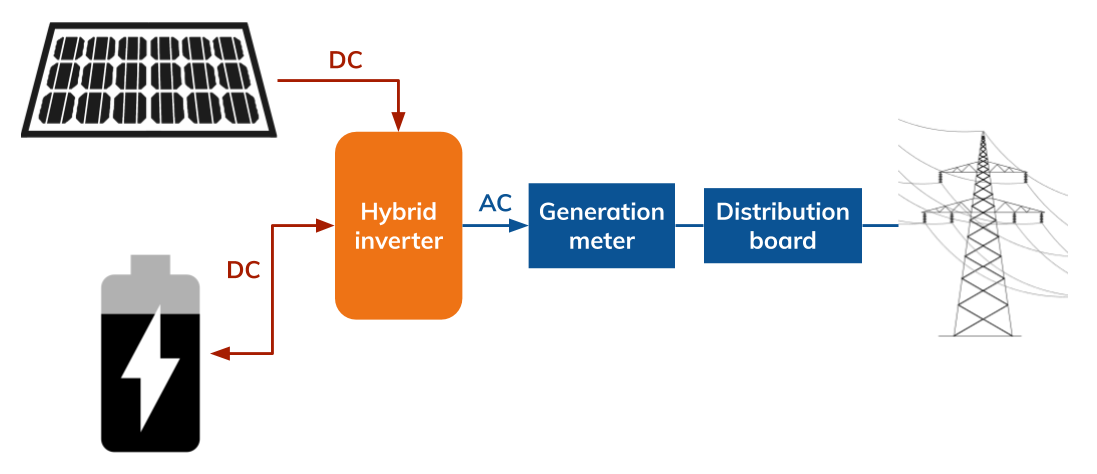
One of the enticing benefits of installing a battery storage system is the potential to have an Emergency Power Supply (EPS) in the event that the grid goes down. Some of the coupling systems provide this (with or without extra components), some don’t. Our guide to battery backup summarises the possibilities of the different systems that we have looked at:
Note that having an Emergency Power Supply is not the same as having a system that allows a grid-connected PV inverter to function when the grid goes down. Without battery storage, grid connected PV systems do not generate electricity when the grid goes down, to avoid exporting into the grid while repairs are being made. However with batteries, it is possible in some cases for generation to continue as long as there is capacity in the batteries and / or a suitable load to utilise the generation.
In order for a PV array to function when the grid goes down, there has to be a safety mechanism in place to prevent the PV system from exporting to the grid. This tends to limit the ratio of the size of the PV array connected to the battery system to the rate at which the batteries can be charged (in other words the battery system must be able to dissipate all of the PV generation in the event of a power cut). With the SMA system this ratio is 2: 1; with other systems this ratio tends to be lower, pretty much 1:1.
In a power cut, the storage system can either provide DC power direct from the battery or it can provide AC power via the inverter. Most customers want the ability to run AC loads.
There are two ways of servicing AC loads in a power cut:
If the inverter has an AC socket, an emergency load can be plugged in and out as required.
The system can be set up with a changeover relay, where AC loads can be run from the grid or battery. The schematic below shows the typical set up for an AC coupled system:

Note that during a power cut, an isolation relay (or manual changeover switch) is operated so that loads are isolated from the grid, and instead run from the inverter.
These systems require either an inverter package that can be switched between on- and off-grid modes, or an installation that includes separate grid-connected and standalone inverters.
The speed of switching between normal (grid connected) and off-grid (power cut) modes will affect how the system is used. Most systems will not operate in the same way as a UPS (uninterruptible power supply) – in other words, the delay in switching will cause loads to switch off on the transition to and from on-grid to off-grid mode. If this is an issue, a separate UPS may be required to ride through the switch cycle.
The storage capacity (usable capacity and maximum depth of discharge) and the charger size will limit the available power (kW) and consumption (kWh) in a power cut. Both the power requirement (kW) and the expected kWh consumption (i.e. backup duration) need to be taken into account in designing any grid backup.
Where a system is designed to have a grid backup, some reconfiguration of the load via a secondary consumer unit may be advisable to ensure that only the loads required in a power cut will draw off the battery in the power cut.
For example, with a DC coupled system, the schematic would look like this:

Battery inverter / chargers are generally single phase. Thus if a battery system needs to be connected to more than one phase of a 3 phase connection, three chargers are needed, along with a battery fuse. One charger is connected to each phase.
Copyright © Spirit Energy 2026 · info@spiritenergy.co.uk · 0118 951 4490
Jobs and Careers
Interested in joining the Spirit team? Email jobs@spiritenergy.co.uk
Spirit House, 25 Albury Close, Reading, RG30 1BD
(Location formerly known as 44 Portman Road, Reading, RG30 1EA)
Spirit Energy is the trading name of Spirit Solar Ltd · UK Company Number 07138647
Although care is taken to ensure that the information on our website (www.spiritenergy.co.uk) and any guides, calculators or checklists provided by us, electronically or otherwise, are accurate and up-to-date, we cannot accept any responsibility for mistakes or omissions. We enter into no express or implied conditions, warranties, terms or representations regarding the quality, accuracy or completeness of the information. We exclude to the extent lawfully permitted all liability for loss or damage, whether direct, indirect or consequential arising out of your use of our website or any guides, calculators or checklists provided by us, or from any information or omission contained in our website or any guides, calculators or checklists provided by us.